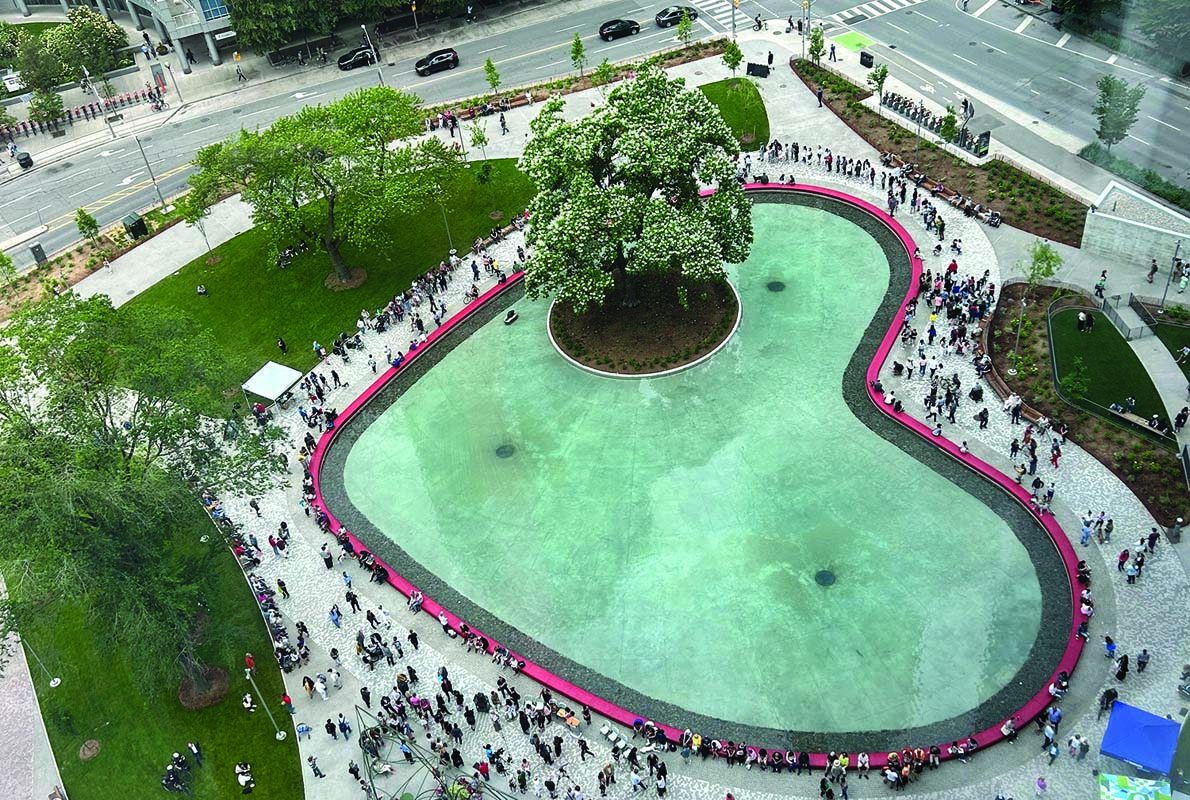Viewpoint: Remembering Claude Cormier

In late October, hundreds gathered by The Ring at Montreal’s Place Ville Marie’s to commemorate the life of landscape architect Claude Cormier, who died at age 63. We assembled around the hot pink casket that Claude had asked his friend Jacques Bilodeau to design: he meant his friends and colleagues to smile, even at his memorial.
I first met Claude after writing my earliest freelance article for Canadian Architect, back in 2003: a thought-piece on kitsch in Quebec design, accompanied by a photo of Claude’s Lipstick Forest in Montreal’s Palais des congrès. Shyly, I knocked at his home-turned-office in the Plateau with a copy of the printed magazine in hand. The door was immediately flung wide: “Perfect!” I recall him saying. “We need a writer for a proposal we’re working on, you can help us!”
Claude’s positive energy uplifted so many. His wit, joy, and ability to create places with universal appeal was evident in works like the pink (and later rainbow) balls that hung above St. Catherine Street’s Gay Village for nearly a decade, the dog fountain of Berczy Park in Toronto, or the split-in-half fountain of Dorchester Square in Montreal. He was also involved in dozens of other projects that paired architecture with landscape: from the National Holocaust Monument in Ottawa with Daniel Libeskind and Edward Burtynsky, to the multi-layered streetscapes of The Well in Toronto.
In a time when design is increasingly concerned with collaboration, Claude’s way of working offers lessons for all designers. He galvanized people around the strength and clarity of his ideas, and simultaneously created space for others to exhibit their talents. One of the last times I spoke with Claude, before knowing of his illness, was interviewing him about The Ring. I remember pressing him: a ring is such an open symbol, what was his core idea? In that firm, but kind way that he had, he told me: he’d done his job in creating the idea as a physical piece in the world. It was my job, as a writer, to articulate the idea in words.
“Yes, the work environment was intense; Claude never stopped until things were perfect,” writes landscape architect Marc Hallé, who began working with Claude as an intern in 2003 and is now a co-president at the firm founded by Claude, now rebranded as CCxA. “But for those who knew him, he radiated light with a positivity and a proactive outlook that kept clouds far at bay. He took every measure to make sure it never rained on our picnic. Although his sunshine came with its fair share of heat, it also motivated people to be their best.”
At the centre of that positivity was a love for the work itself, and a desire to make places that embodied his philosophy of “serious fun.” “It was never about Claude when you spoke to him, and not about you either, but about the work and the joy it brings to others,” writes landscape architect Michael Van Valkenburg. “His designs remind me of the inherent optimism of our field, which goes hand in hand with Claude’s attitude about life. While some insist that the members of a landscape architect’s ensemble stay in their assigned roles, Claude celebrates the anomalous and the episodic: a painted stick standing in for a blue poppy, or an exuberant 50-foot catalpa suddenly endowed with equal parts whimsy and gravitas as it is captured in a perfect, circular, tree-sized island. Claude empowers plants (and people) to do their own thing—the way that he has always done his.”
Claude’s positive energy continued to the end, when he was dying from complications of Li-Fraumeni Syndrome, a rare genetic condition that predisposes carriers to multiple cancers. “I want you all to know: Guys, I’m OK!” he wrote to friends, through a mailing list managed by a close group helping him through palliative care. “I’ve lived a life much longer than I ever expected. Since I was a teenager, I always knew I would die young. My father died at 44. My sister died at 52. I’m 63. I never expected so many years. It was always hanging over my head. All my relatives on my father’s side, 12 of them, all died of cancer. Plus many of my cousins. So I feel very fortunate. My life has been PHENOMENAL. Je suis un homme excessivement privilégié!”
“I feel the love you’re sending me from all over the world—big time! That’s why I’m at peace. Keep sending it! It reinforces all the achievements I’ve had, but I was never really aware of, because I was too busy working to see it all clearly. So keep sending the love. I want to give it back to you!”
The love is still coming, Claude—and the legacy of your projects, and of your way of being, will continue to give so much love back to the world, for decades to come.
